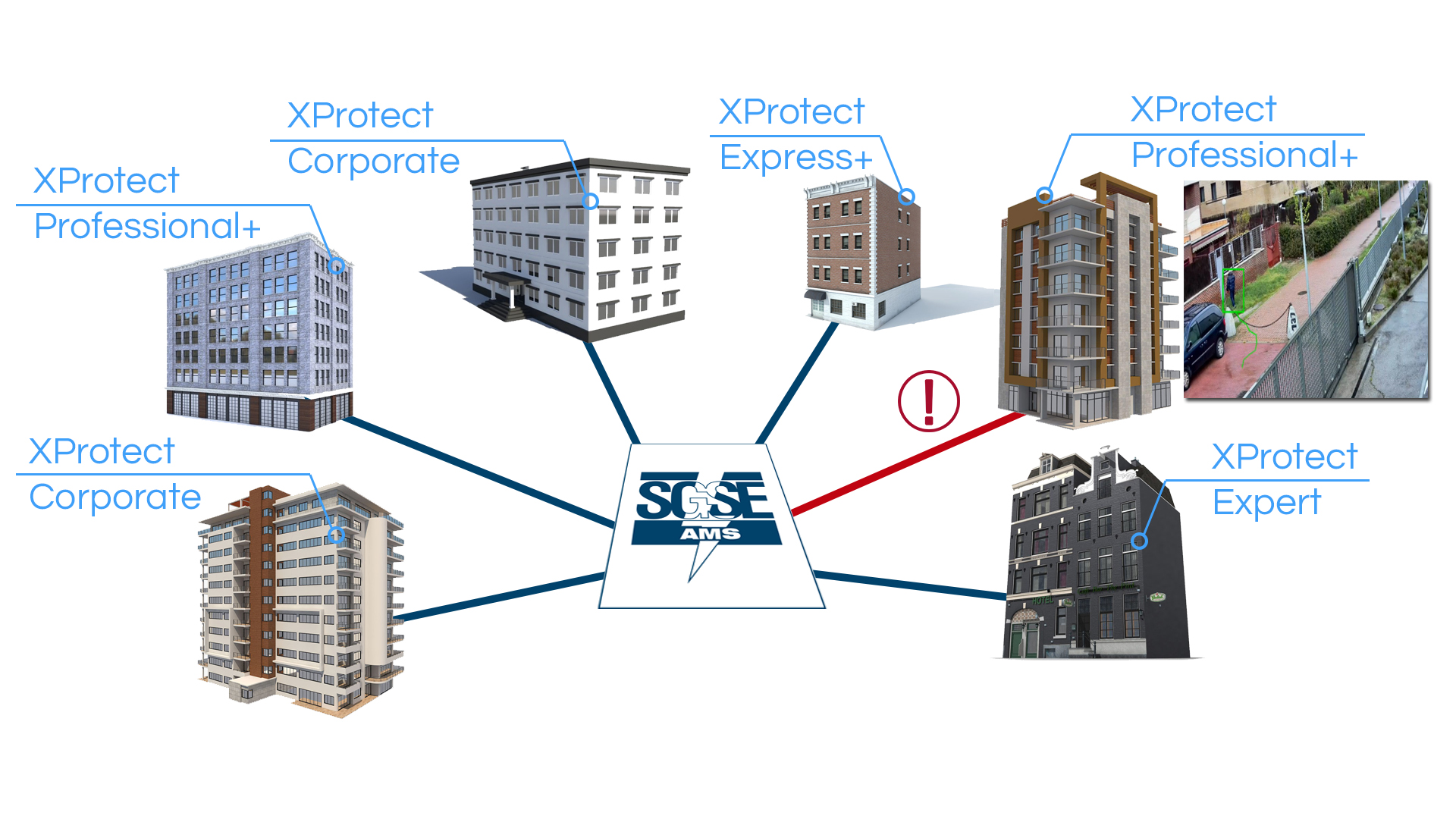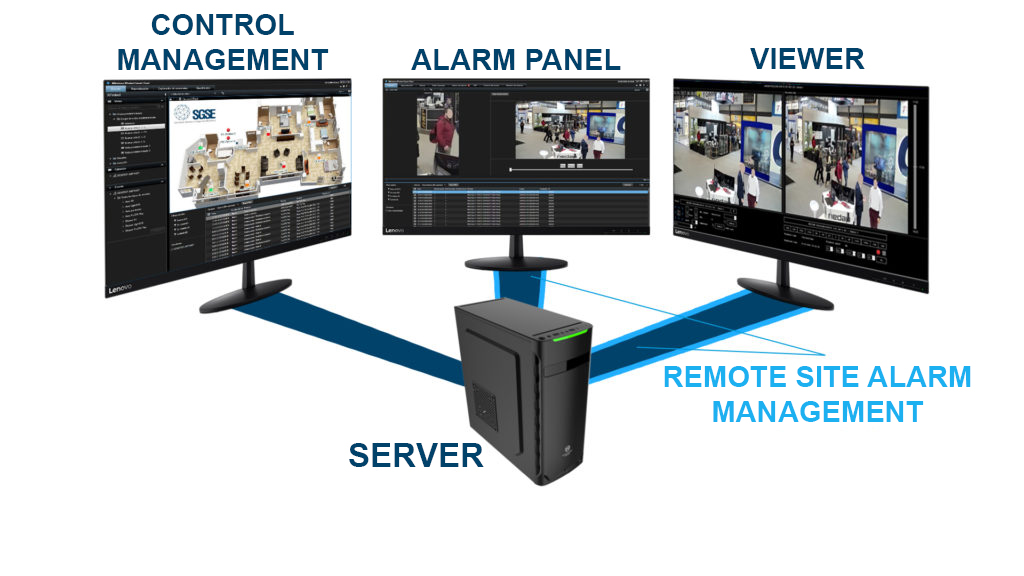
SGSE AMS is a software platform installed in the control centre server that enables the centralisation of multiple remote facilities through the management of alarms.
Working with Milestone Xprotect at remote sites, the alarms can be generated by any of the multiple technologies integrated into this product.

In addition, with SGSE AMS, we can centralise facilities with different software editions from XProtect (from Express+ to Corporate) to adapt our system to the requirements of each site.

A platform that supplements the monitoring centre
Within the operation of a centralised system, the management of alarms during the working day can, for example, be linked to the improvement of productivity and outside these hours, to the protection of a site’s assets.
Let us suppose there is a group of logistic centres in which we want to guarantee the traceability of parcel deliveries and to monitor incidences (unlawful occupation of an loading and unloading area, for example) from a single control centre to check the intruder alarms that go off during the night in each one of the sites, from an alarm monitoring centre.
It would be great if the procedure at both locations (control centre and monitoring centre) was the same, even if the alarms were completely different.
That is why the SGSE AMS procedure is identical to the most advanced video verification from an alarm monitoring centre.

The SGSE AMS alarm gateway
When we centralise from one of the locations in our system, we must be able to verify the alarms quickly and effectively, as happens in an alarm monitoring centre.
That is why SGSE AMS benefits from an alarm gateway like the management software platforms of all monitors in our country that enable the implementation of an operational protocol regarding video verification.
So, when we receive an alarm at SGSE AMS from any of the remote sites, we immediately have an image of it that corresponds to the camera that was previously linked to the said alarm in Milestone.
In addition, the SGSE AMS procedure will benefit from a video clip in its own interface and the reproduction of the 10 seconds before the alarm and 5 seconds afterwards, which can be configured.
In their own alarm gateway interface, operators have a dialogue box with a list of all the alarms received so that they can work quickly on them.

In this way, when an alarm that can be monitored is triggered at the central point, the operator can quickly identify what has happened.
For example, if an intrusion alarm goes off at a facility and the alarm is detected by means of video analysis, besides sending the corresponding alarm to the ARC, the warning which the said intrusion triggered could be received by the control post, along with the graphical information through the associated camera: an image from the moment of detection and a 15-second video clip, from 10 seconds before the detection up to 5 seconds afterwards.
Other examples could be the detection of artificial intelligence (unusual behaviour, searches through advanced filters…), requests for nonauthorised access, reading a black listed number plate, a request for access to a VIP person etc., which are events that, in many cases, are probably not alarms to send to a monitoring centre, but they may be events of interest within a control centre.
In summary, the procedure to be carried out for each of the alarms, regardless of its origin, is the same:
- Alarm reception with an image.
- Reception of a video clip that includes the time of the alarm (pre alarm and post alarm)
- Access to the live video of the camera connected to the alarm.
- Access to the recorded video of the camera related to the alarm
- Management of the alarm
We can see in detail all this operation through the following demonstrative video of the SGSE AMS alarm gateway:
The auxiliary display for the video verification in SGSE AMS
If the image and the video clip do not provide sufficient information to the operator to discern what is happening in the remote installation, the SGSE AM alarms management platform includes a display that can be connected to the live video from the remote facility, as well as navigation for the recorded video.

If necessary in this display, we can switch between the different cameras in the facility from which the alarm has reached us and which we are connected to.
Within the remote management of the facility itself in real time from this display we can control the telemetry of existing PTZ cameras to capture the cause of the alarm in more detail.

With regard to the recorded video, this display allows us to quickly and easily access different points in time from the past as if we were handling Milestone locally, and it is even possible to add the date and time of the point in time of the recording that we want to access.
The sidebar for the events in the recorded video from the SGSE AMS display to create predictive models
 | So that the SGSE AMS operator can quickly understand what has happened at the facility not only at the point in time of the alarm but also in the recent past and to be able to understand the behaviour of the same, in the SGSE AMS display, we have the sidebar for the events in the recorded video. By sliding its cursor, we can reproduce all the alarms recorded at the facility with Milestone from the remote site, as well as directly select them when they appear in another colour within this sidebar. If we can review all the alarms at the facilities in an instant, we can create a predictive model. |
Transcodification in the display
If the connection conditions of the remote site are not the best ones, we will be able to select the characteristics of the video stream that we are showing, to adjust it to the bandwidth available.

Classification of alarms by the SGSE AMS operator
Once operators have all the information necessary to make a decision thanks to the alarm gateway and the SGSE AMS auxiliary display, they can classify the alarm.
Milestone itself makes it possible to perform the simple management of alarms.
In the first place, the alarms can be set so that based on their characteristics (the source, the type of event that triggered them, etc.) this is automatically assigned from one operator to another.

If we do not want the allocation to be automatic, operators will be able to perform the action of “Confirming” the alarm, so that the system and the rest of the operators know that the alarm is already being attended to by that operator.
In addition, when setting an alarm, we can enter a series of instructions that are used to indicate the protocol that the operator should follow when the reliability of this alarm is confirmed, or the steps to take in order to verify this.

The following step is that of “Put on hold”. The list of conditions which can set off an alarm is also configurable, in case we need more alarm conditions than those set by default, to enable us to carry out our procedure.

At the time of switching off an alarm, Milestone allows us to configure whether we want it to be necessary to apply a reason for switching off the alarm, and to choose from a list of options, with the option of including commentaries by the operator.

The list of reasons that can be applied to switching off an alarm is also fully configurable by the system administrators, and can therefore fully adapt to the characteristics and necessities of the facility type.

Another option that management of the alarm offers to the operator is that of being able to easily provide feedback about the alarm, In this way, the operator can bring human value to reviewing possible issues with the system.
The system also enables us to be able to consult all the previous actions that have taken place regarding an alarm, from its creation and its allocation to an operator, to the point in time and reason for shut down, through to possible status changes and possible observations and comments that the operator has been able to make.

The auxiliary display sample video for the video verification in the SGSE AMS
As a summary of all the aforementioned regarding the exploitation of the SGSE AMS support viewer, you can find below the video demonstrating the full operation of said viewer:
From LOCAL to GLOBAL management without resource consumption
One of the great benefits of SGSE AMS is that it can be installed on the NVR server on which the existing base licence of the current Milestone software edition was previously installed.
We can easily turn one of the facilities of the group of sites into the control centre of the system to go from the local management of a specific facility to the global management of THE WHOLE system.
Installing SGSE AMS does not require an additional server or extensions in which it has Milestone with which no additional resources are consumed.
Having developed around the SDK of Milestone, SGSE AMS remains established as another service from Milestone that acts as the main control centre and all that that implies in terms of software resources consumption as well.
SGSE AMS is becoming a Milestone service from the control centre.

Like centralised architecture, SGSE offers to deploy your powerful WKS-MILESTONE-4MON workstations of up to 4 monitors thanks to their nVIDIA Quadro P4000 graphics card.
With these workstations we can visualise both the local and global management of SGSE AMS as illustrated in the image below.

Centralise your facilities through alarm management by working with SGSE AMS

